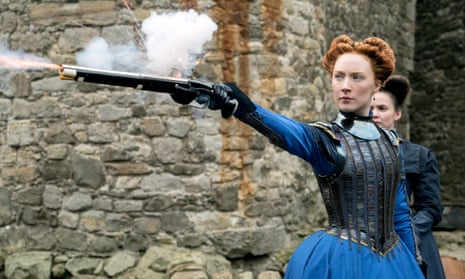Saoirse Ronan’s face looms out of the screen in this period movie like the figurehead on a warship’s prow: fierce, sharp, defiant. She inhabits the persona of Mary Stuart so utterly that it took me a moment to remember that it was this same performer who only last year was starring in Lady Bird, a modern-day teen at war with her mum. They were so different, although with points in common. This is another excellent performance. But she is one half of a lopsided double-act, and this film’s inability to decide whether Mary and Elizabeth I are enemies or allies means that Margot Robbie’s performance as Elizabeth is nowhere near as confident.
The young widowed Mary arrives back in Scotland from France in 1561, a Catholic claimant to that country’s throne and a proud believer in her additional right to England’s crown, superior to that of the incumbent: Elizabeth I, her cousin and defender of the (Protestant) faith. Mary puts herself under the protection of her dubiously loyal half-brother James, Earl of Moray (James McArdle), and for England her mere presence is an intolerable provocation. It is the beginning of an opaque and deadly strategic confrontation with Elizabeth, something between a duel and also a kind of love affair, or cousinmance, two women who know what it is like to be lonely and surrounded by duplicitous men. Perhaps, like the destroyer’s captain and U-boat commander in a war movie, they have a kind of respect for each other.

Advised by courtier William Cecil (Guy Pearce) in silky, nasal tones, Elizabeth embarks on a decades-long game of diplomacy and threat with Mary, in which she is to offer up her own beloved favourite Robert Dudley (Joe Alwyn) as a possible husband for her, whose role would be to subdue and control the Scottish queen in the English interest. Mary accepts instead the opportunist romance of Catholic Henry Darnley (Jack Lowden), who wants this marriage to reclaim his own lands and wealth and is another male schemer, along with Mary’s eventual third husband, Lord Bothwell (Martin Compston). All the time, Elizabeth is persuaded to use the screeching, preaching misogyny of the Church of Scotland’s John Knox (David Tennant) as a means of destabilising Mary.
This is a heartfelt, serious-minded film about 16th-century power politics from screenwriter Beau Willimon and director Josie Rourke, theatrically conceived, and influenced by Shekhar Kapur’s Elizabeth (1998). It is much more open about sex than we’re used to in dramas about Mary Stuart. Friedrich Schiller’s 1800 play about Mary, for example, did not show her getting her period or enjoying premarital cunnilingus from Darnley (“Do you need to …?” she asks afterwards. He diffidently replies: “No, don’t worry about me.”) It could be the modern sensibility that made Willimon and Rourke create a kind of trans identity for Mary’s court intimate David Rizzio (Ismael Cruz Cordova) but they also, entirely plausibly and without anachronism, show Elizabeth yearning to become a man.
As with other treatments of Mary’s life, this movie has to invent a face-to-face meeting with Mary and Elizabeth that never happened, a fiction that unfortunately makes their apartness in the rest of the movie feel frustrating. However, Rourke and Willimon create elegant initial scenes in which the queens allow introductory portraits of themselves to be sent back and forth: Elizabeth’s is pointedly larger than Mary’s – and there is an interestingly surreal moment when a lady-in-waiting has to hold it up in front of her face, like an avatar.
Ronan is just so good in this movie – so intelligent, so passionate, but she upstages Robbie, and Robbie’s parts of the film, often lumbered with leaden historical exposition dialogue, especially from Pearce, don’t have the same snap. Perhaps Elizabeth comes off disconcertingly badly because there is, dramatically, only room for one proud-yet-vulnerable 16th-century queen in a film about proud-yet-vulnerable 16th-century queens, so they must compete for a finite supply of queenly mannerisms. Yet that final meeting between the two women is a showstopper, especially Mary’s angry spasm of pride in calling Elizabeth her inferior. It is an aria of tragic scorn.

Comments (…)
Sign in or create your Guardian account to join the discussion